George Gooderham
«Prev 1 2 3 4 5 6 ... 7» Next» » Slide Show
1881 Toronto Island Connections
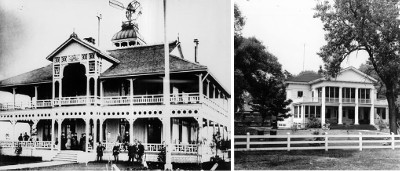
First Toronto Island RCYC Clubhouse, 1884 TPL Geo. Gooderham house, Aug. 1954 CTA
After the physical link was severed, ships could enter Toronto harbour through an Eastern Gap, as well as the original, more distant Western Gap. Many of Gooderham & Worts’ vessels undoubtedly saved time as a result, delivering raw materials like coal and corn to the growing distillery and distributing Gooderham & Worts products to far-flung customers.
By the 1880s, the successful distillers appeared to have more leisure time to enjoy. Although founding partner William Gooderham, who died in 1881, does not appear to have been a yachtsman, his sons and descendants ranked among some of the keenest and most successful of Toronto’s sailors. It was this love of sailing that drew Gooderhams to the Toronto Island, where the Royal Canadian Yacht Club (RCYC) opened its first Island clubhouse in 1881 overlooking Toronto Bay. Just south of the club, George Gooderham built his large summer “cottage” overlooking Lake Ontario from (what became) 244 Lakeshore Avenue (see plan). Sadly no contemporary images of this impressive house have been found, but a photograph taken in August 1954 for the Globe and Mail shows the grandeur that was … shortly before it was demolished during the Island Clearances of the 1950s and ’60s courtesy of Metro Toronto.
As for the first RCYC clubhouse house on the Island, it was built in the popular “stick style” of its day, exuding a rustic charm in tune with its natural surroundings ... and some of the cottages beginning to rise elsewhere on the Island. No Gooderhams were among the founders or early members of the yacht club, which had been established in 1850, become “Royal” in 1854, and occupied various locations along the Esplanade before hopping across the water in 1881. George Gooderham joined the club in 1875 while it was still based on the mainland. Then, after the move to the Island, four of his brothers and three of his sons also joined the club between 1881 and 1886. And during the decade of 1883 through 1892, George Gooderham in Oriole I and II and his oldest son William George Gooderham in Aileen won an astonishing nine of ten Prince of Wales Cups – the prestigious trophy donated by HRH Prince of Wales during his visit to Toronto in 1860. Family competition on the water, as perhaps elsewhere, must have been fierce. George Gooderham acted as Commodore of the RCYC in 1888, a position also held by two of his descendants, son George H. Gooderham and grandson Norman Gooderham.
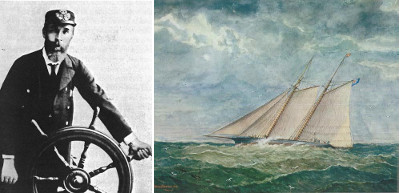
George Gooderham at the helm of Oriole I George Gooderham’s beloved Oriole II in 1888 painted by fellow
in 1882 RCYC member William Armstrong
During this early period, racing and social life focused on the Island clubhouse, but many vessels were moored elsewhere. In 1947, maritime historian C. H. J. Snider described summer life at the east end of Toronto Bay:
Up to the 1900’s the east end of the Bay in summertime was enlivened by the [Gooderham] family fleet at moorings off the foot of Trinity street – Commodore George’s Oriole, “Mr. Willie’s” Aileen, George H.’s Vivia, and the steam yachts Abcona and Cleopatra, the latter a handsome steel sample of George Lennox Watson’s skill from the Clyde [Scotland]. Every afternoon at 3 o’clock the Oriole’s mainsail would rise and the Bobs, a little steam tender, would put off from the mill wharf to bring the owner and his guests, for the day aboard.
By the 1880s, of course, the Gooderham & Worts wharf was a very busy place, alive with steam and sailing ships of all sizes and purposes. Navigating the little Bobs through such crowded waters to the awaiting Oriole presented a distinct challenge to her skipper.
George Horace Gooderham acted as RCYC Commodore for 15 years, from 1900 to 1901 and 1918 to 1930, and as Vice-Commodore in other years. Two events of great importance occurred during this thirty-year period: one disaster and one grand occasion.
On August 15, 1904, the charming but aging clubhouse burnt down. Vice- Commodore George H. Gooderham was on the scene almost immediately, but the City’s firemen didn’t arrive until the building had been consumed by flames. Commodore Stephen Haas assured the Globe reporter that “rebuilding operations would be commenced immediately on a larger and more extensive scale.” And so they were. In 1905, the coolly elegant classicism of Sproat & Rolph replaced the rustic informality of the old clubhouse and set the tone for the future. Sadly, this second Island clubhouse was also destroyed by fire in 1918 and only replaced by today’s splendid clubhouse in 1922.
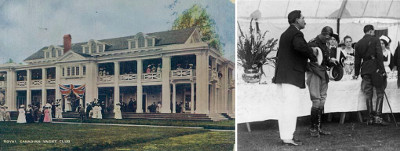
RCYC’s second, grander Island clubhouse, ca. 1905 Commodore George H. Gooderham with
Edwardians gather for a splendid celebration Prince of Wales,1919
Even without a “real” clubhouse, however, the RCYC, offered HRH Prince of Wales (future Edward VIII) a brilliant welcome during the young prince’s triumphant post- Great-War visit in August 1919. And it was RCYC Commodore George H. Gooderham who presided. On August 25th, the khaki-clad prince was swept off to the Island aboard the club launch, Hiawatha (still in use), with Royal Standard snapping in the breeze. As he landed at the specially built wharf (known thereafter as the Prince of Wales Landing), the prince was greeted by the Commodore, who escorted him aboard the Gooderham’s flag-draped flagship, the four-masted Oriole III, and around the grounds where the prince laid the cornerstone for the new clubhouse. He then presented that year’s Prince of Wales Cup to Norman Gooderham and enjoyed a snack and a smoke (after locating a match), before leaving, only to return for the evening’s festivities. At one point during the ball, the prince excused himself. Eventually, he was discovered relaxing aboard the Oriole III, moored in a lagoon and surrounded by canoes and singing admirers.
Norman Gooderham continued the family traditions of winning races (in the final Oriole IV) and filling the role of Commodore from 1933 to 1936. Built in 1921, shortly before W. G. Gooderham and family decided to sell the distillery to Harry C. Hatch in 1923, the Oriole IV was “thought to be the most majestic of all R.C. Y. C. flagships,” and is now the oldest commissioned ship in the Canadian Navy. Quite a tribute to the 30-metre yacht, her builders and owners.

Goad Plate 30, 1890, detail of Lakeshore south 238 Lakeshore Avenue, early 1880s before the first
of RCYC with location of several once and future Gooderham arrived ca. 1904, reproduced in a
Gooderham cottages Centre Islander of 1945
Many Gooderhams made their way over to the Island after George had established a beach head at 244 Lakeshore in the early 1880s. Family sleuth Gay Gooderham has discovered Gooderham connections to the following early cottages: 238, 242, 244, 246, 270 and 274 Lakeshore – some bearing the name “Gooderham,” others bearing the married name of Gooderham women. There are probably other Gooderham cottages, but these establish a distinct family cluster near the RCYC. Many occupants were sailors and all enjoyed the particular joys of Island life – swimming, sunning, cycling, and lounging around with friends.
It’s very difficult to find early accounts – by Gooderhams or others – of life on the Island in those days. Sadly, nothing has surfaced from this period. Fortunately, however, two occupants of 238 Lakeshore at the corner of Lakeshore and Chippewa (formerly Lakeview) have very strong memories of their Island childhoods in the 1940s and ’50s, Virginia (Grant) Ridpath and Susan (Grant) Freeman.
“My first boat ride (1940) was on the Kwasind, the RCYC launch at eight days of age,” recalls Ms. Freeman. Like her older sister Virginia, she was brought directly to 238 Lakeshore Avenue from the hospital where she was born.
The Grants – like residents from Hanlan’s Point to Ward’s Island – arrived for the May 24th week-end. They recall the bustling, commercial Main Drag at Centre Island, the Lamantia brothers’ fruit cart, the adventures at the RCYC and along the beaches. During the floods of the early 1950s, they could canoe around the house. During the summer, their father – like other Island dads – would don the usual jacket-and-tie … and cycle to the boat. Bill Grant was, of course, an avid sailor, who skippered his 50- foot sloop, White Wings, while his brothers also raced. The Grants stayed until Thanksgiving, so the girls would take the Kwasind across the Bay and hop on the streetcar to go to school. Then the house disappeared and the yearly connection was broken.
However, the Grant sisters continued to visit the site of their beloved 238, where the steps from the boardwalk remain, to sit on a nearby bench, and dig up some of “their” sweet-scented Lilies-of-the-valley that still bloom where they had been planted long ago.
Shortly after the Gooderhams started taking up residence on Toronto Island, Charles E. Goad, father of the historically vital Canadian fire atlases, also established himself there. Like the Gooderhams, Goad was a keen sailor who followed the Club to the Island. His lovely stick-style cottage – Floreat – was located on the edge of Ward’s Pond, between the Gooderhams on Lakeshore Avenue, and the Club overlooking the Bay (see green circle on 1890 plan).
Goad knew the Gooderham & Worts distillery extremely well. In fact, his 1880 plan of the site provides the most detailed view of the distillery for that period. Naturally, his plans for the Toronto Island – including the details reproduced here – provide critical evidence of its development. For about 20 years, Goad lavished attention on his Island property. Filling and improving the marshy surroundings. Carving out islands and waterways. Operating his own little steam launch, the Florissant, that he liked to race against the RCYC’s brand new Hiawatha. Expanding and decorating Floreat. And building houses for other family members. He celebrated his Island connection with an exquisite bird’s-eye-view of Floreat and surrounding cottages, with directions to the RCYC where he was a life member from 1890 on.
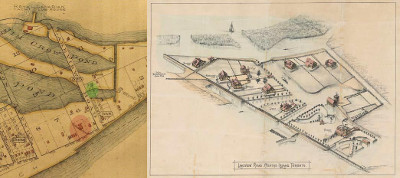
Detail from Goad’s 1890 Island plan Goad’s bird’s-eye view of “Floreat” and her neighbours along
RCYC (top), Charles Goad (green), Lakeview (later Chippewa) Road, ca 1897 J Goad
George Gooderham (red)
During the 1930s, when Gooderhams and Goads continued sailing and otherwise enjoying Toronto Island life, another connection between the distillery and the Island emerged. Harry C. Hatch, who had purchased Gooderham & Worts in 1923 and merged it with Hiram Walker in 1927, joined the RCYC in 1937. By this time, Hatch had amassed great wealth, his horses had already won several King’s Plates, and the yachting world beckoned. Whether he had a personal launch is unknown. But if he did, it would have travelled to the Island from the new Gooderham & Worts dock built at the foot of Parliament Street around 1930, not far from where the Gooderham “family fleet” celebrated by C.H.J. Snider used to be moored.
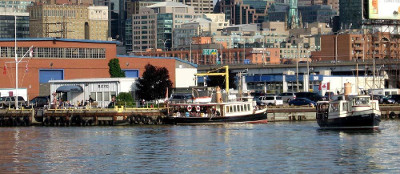
RCYC landing (left) at end of old G&W wharf, with both Hiawatha (centre) and Kwasind (right)
Today the close historical connection between the distillery and the Island is symbolized by the location of the RCYC city landing on the tip of the post-war extension of the Gooderham & Worts wharf at the foot of Parliament Street. The 1905 Kwasind that has ferried generations of members across the Bay still operates on a daily schedule. The even more historical Hiawatha that was built in 1895, carried earliest members (Gooderhams among them), and transported such luminaries as the Prince of Wales now appears for special occasions. On a lucky day, both launches can be seen bobbing in the old G&W slip.
Many thanks to Gay Gooderham for sharing her research about Gooderham connections to the Toronto Island and the CHJ Snider article from a January 1947 issue of the Evening Telegram; Virginia Ridpath and Susan (Grant) Freeman for sharing their memories of 238 Lakeshore from the late-1930s to the ’50s; and Diane Blake, archivist at the RCYC, for tracking down and sending information about the Gooderhams, Goads, and Hatches.
For more about the history of the RCYC see John Ross Robertson, “Royal Canadian Yacht Club,” in Landmarks of Toronto, vol. 2 (1896); and C. H. J. Snider’s two Annals of the Royals Canadian Yacht Club published in 1837 and 1954. And for more about the history of the Toronto Island, see Sally Gibson’s 1984 More Than an Island: A History of the Toronto Island.
For photographs of Goad’s Floreat and surroundings, visit the City of Toronto Archives to view James L. Goad fonds 1109, which contains 34 photographs taken between 1890 and 1912.
Written by Sally Gibson, and published online under Heritage Snippets, August 3, 2008, at http://www.distilleryheritage.com
1881 Toronto Island Connections
By the 1880s, the successful distillers appeared to have more leisure time to enjoy. Although founding partner William Gooderham, who died in 1881, does not appear to have been a yachtsman, his sons and descendants ranked among some of the keenest and most successful of Toronto’s sailors.
| Owner of original | published online under Heritage Snippets, August 3, 2008, at http://www.distilleryheritage.com |
| Linked to | Royal Canadian Yacht Club (RCYC), Toronto, ON, Canada; George Gooderham; George Horace Gooderham; William George Gooderham, I |
«Prev 1 2 3 4 5 6 ... 7» Next» » Slide Show


